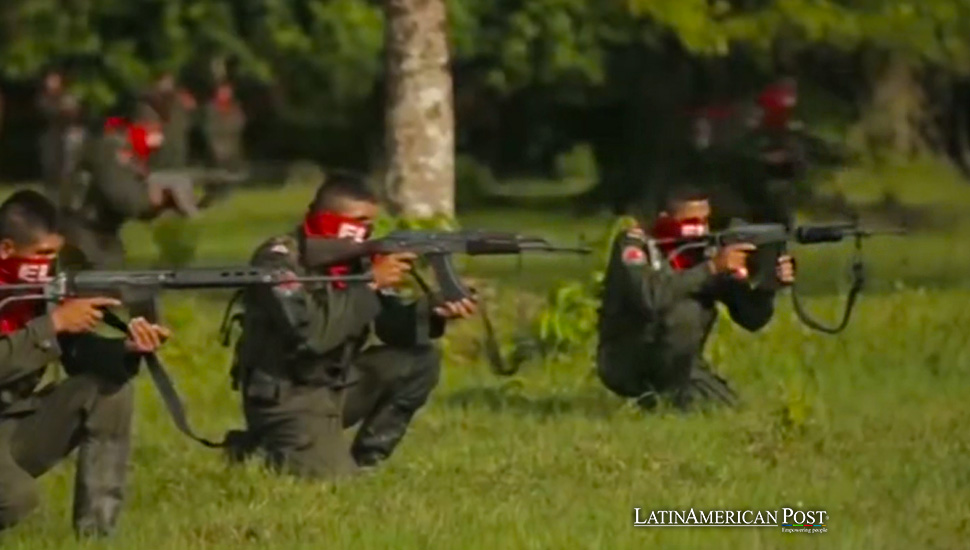Decrease of 33% in Armed Clashes Between Colombian Armed Groups and Military in 2023

In 2023, Colombia witnessed a significant decrease of 33% in armed clashes between armed groups and the Colombian Armed Forces, resulting in a 17% reduction in emergencies related to forced displacement and confinement, as reported by the United Nations Office for the Coordination of Humanitarian Affairs (OCHA)
A Glimpse into Colombia’s 2023 Statistics
In 2023, Colombia experienced a notable downturn of 33% in confrontations between armed factions and the Colombian Armed Forces, yielding a 17% decline in crises linked to forced displacement and confinement, as unveiled by the United Nations Office for the Coordination of Humanitarian Affairs (OCHA) in its recent report.
As per OCHA’s Humanitarian Country Team (HCT), the previous year, they witnessed 63,249 individuals affected by large-scale displacements, marking a 23% downturn from 2022. Additionally, 88,007 people grappled with confinement due to threats and armed clashes across various regions, reflecting a 14% decrease compared to the preceding year.
While bilateral truces between the national government and diverse armed factions contributed to mitigating violence, skirmishes persisted, often tied to the territorial expansion endeavors of such groups. These confrontations continued to be a significant catalyst for mass displacements (43%) and confinement incidents (34%).
Escalation in Extortion and Child Exploitation: Disturbing Trends Unveiled
The report underscored an alarming escalation in extortion activities, totaling 10,263 cases in 2022. Moreover, there was a stark surge in the recruitment and exploitation of children and adolescents, with 251 documented instances, marking a staggering 93% rise from 2022, posing significant threats to their rights and exacerbating the displacement crisis.
Furthermore, access to humanitarian assistance encountered mounting impediments, with 240 recorded incidents nationwide. These restrictions primarily stemmed from threats, entry constraints, military operations, and ongoing hostilities.
Despite a 32% decrease in casualties from Anti-Personnel Mines (APMs) employed by armed groups, which resulted in 95 fatalities compared to the previous year, the overall count of mine-related incidents climbed to 929 in 2023.
Colombia grappled with many natural and anthropogenic disasters exacerbated by El Niño and droughts, affecting over 399,806 individuals. The Amazon River’s drought, in particular, inflicted severe repercussions on indigenous communities, accentuating the vulnerabilities faced by marginalized groups.
A Deep Dive into Colombia’s Humanitarian Landscape
Historical context proves invaluable in understanding the complexities of Colombia’s humanitarian landscape. Decades of armed conflict, dating back to the mid-20th century, have left deep scars on Colombian society. The rise of leftist guerrilla groups, such as the Revolutionary Armed Forces of Colombia (FARC), and right-wing paramilitary organizations fueled a cycle of violence, displacement, and human rights abuses, claiming countless lives and displacing millions of Colombians from their homes.
While the Colombian government has made strides in recent years toward peace negotiations and demobilization efforts, pockets of conflict persist, often fueled by drug trafficking, territorial disputes, and socioeconomic inequalities. Implementing the 2016 peace agreement between the government and the FARC marked a significant milestone. Yet, challenges remain in its full realization, with sporadic outbreaks of violence and the emergence of new armed groups complicating the peace process.
Also read: Mexican Armed Forces Uncover Largest Meth Lab Amid Uptick in Drug Trafficking
Against this backdrop, the findings of OCHA’s report shed light on Colombia’s ongoing humanitarian challenges. Despite progress in certain areas, such as the reduction of armed clashes and displacement emergencies, the lingering effects of conflict, coupled with environmental pressures and socioeconomic disparities, underscore the need for sustained international support and comprehensive strategies to address the root causes of instability and insecurity in Colombia.




